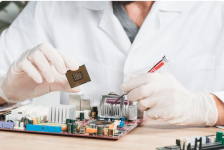In an era obsessed with apps, AI, and cloud-based everything, it’s easy to forget the solid foundation underneath it all—hardware. It’s not flashy. It doesn’t go viral. But without it, the digital world would be a blank screen.
Hardware is the heartbeat of technology—the metal, wires, chips, and circuits that turn invisible code into living, breathing experiences. If software is the brain, hardware is the body. And without a body, even the smartest brain goes nowhere.
Let’s break it down. Hardware isn’t just your PC or phone. It’s every physical component that makes computing possible:
The story of hardware is nothing short of revolutionary. Decades ago, computers filled entire rooms. Today, they fit in your wristwatch. Thanks to innovations in microprocessors, transistors, and nanotech, hardware keeps getting smaller, smarter, and more powerful. Moore’s Law (the idea that computing power doubles roughly every two years) has fueled this evolution, bringing us:
Think of:
AI-powered smartphones adjusting camera settings in real time
With the rise of sustainability, the next big leap is in eco-friendly hardware. Think:
The next time your app loads instantly or your video edits render in seconds, thank the unsung hero—your hardware. It’s easy to overlook the wires and silicon when the screen is glowing with possibilities, but behind every line of code is a piece of tech that made it real.
Hardware isn’t just machinery—it’s the muscle of innovation. And the future? It’s metal, modular, and more magical than ever.
Hardware is the heartbeat of technology—the metal, wires, chips, and circuits that turn invisible code into living, breathing experiences. If software is the brain, hardware is the body. And without a body, even the smartest brain goes nowhere.
From Circuit Boards to Superpowers
Let’s break it down. Hardware isn’t just your PC or phone. It’s every physical component that makes computing possible:
 Motherboards
Motherboards Processors
Processors Memory chips
Memory chips Graphics cards
Graphics cards Power supplies
Power supplies Sound systems
Sound systems Peripherals (printers, keyboards, and beyond)
Peripherals (printers, keyboards, and beyond)
Evolution: From Room-Sized to Pocket-Sized
The story of hardware is nothing short of revolutionary. Decades ago, computers filled entire rooms. Today, they fit in your wristwatch. Thanks to innovations in microprocessors, transistors, and nanotech, hardware keeps getting smaller, smarter, and more powerful. Moore’s Law (the idea that computing power doubles roughly every two years) has fueled this evolution, bringing us:
- Lightning-fast gaming rigs
- Ultraportable laptops
- Smart home devices
- Wearables with health-tracking capabilities
- AR/VR gear that redefines reality
AI + Hardware = Next-Level Intelligence
What happens when cutting-edge hardware meets artificial intelligence? Magic. Or at least, something close.Think of:
AI-powered smartphones adjusting camera settings in real time
- Self-driving cars processing billions of data points per second
- Smart appliances learning your habits
- Neural processing units inside your phone enabling real-time translation
Greener Machines, Smarter Designs
With the rise of sustainability, the next big leap is in eco-friendly hardware. Think:
- Biodegradable circuit boards
- Energy-efficient chips
- Modular designs for easy upgrades
- E-waste recycling programs
Final Thought: Respect the Metal
The next time your app loads instantly or your video edits render in seconds, thank the unsung hero—your hardware. It’s easy to overlook the wires and silicon when the screen is glowing with possibilities, but behind every line of code is a piece of tech that made it real.
Hardware isn’t just machinery—it’s the muscle of innovation. And the future? It’s metal, modular, and more magical than ever.

